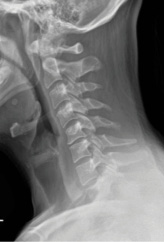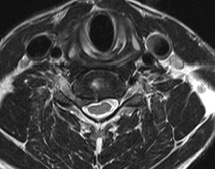CASE report
By Ehsan Jazini, MD
.jpg)
Ehsan Jazini, MD
Education:
Areas of Interest:
28-year-old male presented with 6-week history of right-sided neck pain and right bicep, dorsal forearm and first- and second-digit pain and numbness. He also reports objective weakness of the right arm. The patient notes his pain began after sleeping in an uncomfortable position on a couch. He does note a similar episode a few months back; however, he notes it was much less severe and resolved within a few days. At this point the patient has tried a prednisone taper which did improve his pain slightly, however he still rates his pain 6 to 8 out of 10 on the visual analog pain scale. His neck to arm ratio 70:30. He denies difficulties with balance or dexterity. He denies specific exacerbating or alleviating factors regarding his pain.
Examination
No acute distress, AOx3, positive Spurling’s on the right.
| Cervical Neurological Exam | |
|---|---|
| Fasciculations | Not present bilaterally |
| Hoffman’s | Not present bilaterally |
| Clonus | Not present bilaterally |
| Babinski | Not present bilaterally |
| Biceps Reflex | 2/4 bilaterally |
| Brachioradialis Reflex | 2/4 bilaterally |
| Triceps Reflex | 2/4 bilaterally |
| Grip Strength | 5/5 bilaterally |
| Intrinsics Strength | 5/5 bilaterally |
| Finger Flexor Strength | 5/5 bilaterally |
| Finger Extensor Strength | 5/5 bilaterally |
| Wrist Flexor Strength | 5/5 bilaterally |
| Wrist Extensor Strength | 5/5 left | 4/5 right |
| Biceps Strength | 5/5 left | 3/5 right |
| Triceps Strength | 5/5 bilaterally |
| Deltoids Strength | 5/5 bilaterally |
| Shoulder Atrophy | Not present bilaterally |
| Arms/Forearms Atrophy | Not present bilaterally |
| Hand Atrophy | Not present bilaterally |
Cervical x-rays demonstrated loss of cervical lordosis with 50%-disc collapse at C5/6 with focal kyphosis. Mild scoliosis in his neck with apex at C5/6, <10 degrees.
Cervical MRI demonstrated large right foraminal stenosis at C5/6 causing severe foraminal stenosis and cord displacement.
Initial recommendation was epidural steroid injection and PT with close follow up in 2 weeks.
Patient reported continued right interscapular pain, arm weakness, arm numbness. Right biceps was 3/5, wrist extension 3/5 on the right.




One level ACDR, prodisc C Vivo at C5-6. Vivo was selected due to relative domed shaped at C4-5. In this case given patient’s young age and no evidence of facet arthropathy on cervical radiographs CT was not obtained. Intraoperative fluoroscopy and findings after complete discectomy and release confirmed the decision making to stick with prodisc C Vivo due to endplate morphology.





Results
Complete resolution of neck and arm pain with great restoration of motion and alignment goals.
| Motion analysis (AI generated) Adjacent: physiologic motion & abnormal level |
||||
|---|---|---|---|---|
| Pre-Operative | Flexion (kyphosis) |
Extension (lordosis) |
Difference (degrees) |
|
| C4/5 | 5.8 | 6.1 | 11.9 | |
| C5/6 (abnormal) | 5.5 | 0.7 | 6.2 | |
| C6/7 | 5 | 2 | 7 | |
| 6 Months | Flexion (kyphosis) |
Extension (lordosis) |
Difference (degrees) |
Net Motion (degrees) |
| C4/5 | 6 | 6.2 | 12.2 | 0.3 |
| C5/6 (abnormal) | 6.5 | 6 | 12.5 | 6.3 |
| C6/7 | 6 | 1 | 7 | 0 |
| Cervical Alignment | Pre-Operative | Post-Operative | ||
| C2-7 degrees | 6 kyphosis | 8.6 lordosis | ||
AI Motion Analysis Interpretation
Physiologic motion at upper levels are usually higher than lower levels as confirmed here. There is a relative lack of motion at C5-6 compared to C4-5 being down by 50%.
After surgery the motion at C4-5 and C5-6 are nearly identical with no changes at C6-7.
The net motion gained is virtually all at C5-6.
Alignment improved from 6 degrees of kyphosis at 8.6 degrees of lordosis.
EDUCATIONAL development
Centinel Spine offers a variety of educational programs tailored to meet the diverse training needs of physicians. Hands-on Bioskills Courses, Peer-to-Peer Webinars, and OR Surgical Observations have been designed to review patient selection, surgical technique and tips, post-operative care, and other related topics. These programs can be customized to individual physician needs, providing varied levels of support to surgeons.

About our
Hands-on Bioskills Courses
These courses provide surgeons with an educational experience focused on patient selection, surgical technique, strategies, and solutions for addressing specific spinal pathologies. The course format includes lectures, case discussions with expert faculty, and a bioskills lab.
The curriculum covers biomechanical considerations, indications and patient selection, surgical technique, tips and tricks, post-operative care, and best practices.

About our
Peer-to-Peer Webinars
Centinel Spine’s live streaming webinars provide a convenient way for physicians to learn from experts in motion preservation discussing specific treatments, techniques, and strategies for patient care.
Our interactive webinars allow participants to pose questions, receive answers, and exchange ideas in real-time with their surgeon peers from the comfort of their homes or offices.

About our
Surgical Observations
Surgical Observations are a surgical technique training and continuing education program that exposes surgeons to the technical procedures and skills required for anterior column surgery, through a combination of case discussions and viewing live surgery.
Surgeon OR Visitations are offered at Centinel Spine experienced faculty locations, where key thought leaders in spine educate with a focus on the anterior spinal column.
Watch this short primer on Centinel Spine and its unique and extraordinary place as a catalyst of change in the spine industry—with pioneering technologies and a clinical history that have led to successes ranging from PGA champions to a growing list of surgeon-patients.
Watch the Video